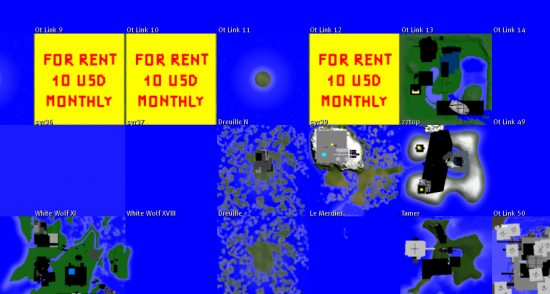Correction: Coral Estate regions start at $20, not $10.
OpenSim hosting prices have fallen to a record-low, with providers like New Voice offering regions for just $10 per month — though the performance of such low-cost regions may be in doubt.
New Voice on the map
If you’ve glanced at the map of OSGrid recently, you might have seen bright yellow squares here and there, marked as for rent at $10 each. That’s right. $10. For a region.

And those yellow squares are for real. They land is offered by New Voice, d.i., an Italian technology company that’s been in business since 2005, for $10 for a full region, no setup fees.
So how much can these regions hold? Most customers have up to 10,000 prims, he said, but there’s no absolute maximum. In fact, in testing, the regions didn’t crash until 60,000 prims, said New Voice operating officer Enrico Ranucci.
“We tested on 30,000 and it was a bit laggy,” he added. “It depends also on textures and scripts, of course.”
OSGrid, for those new to OpenSim, is the single largest public grid in the OpenSim universe, with more than 5,000 regions and over 47,000 registered users.
This is a drop in the bucket compared to the million users who log into Second Life each month — but low, low prices such as those offered by New Voice may inspire a few more emigrants to make their way over.

Ranucci told Hypergrid Business that New Voice can offer such low rates because it owns its own hardware, instead of renting it from third-parties, and owns its own Internet connection — a side benefit of being in the telecommunications industry. The company currently owns 150 servers, 10 of which are currently being used for OpenSim.
In addition, he said, $10 a month is not an unusual price. In fact, many hosting providers can match it — if customers are willing to buy in bulk.
“In December, we rented a full server from one of your Hypergrid Business advertisers,” Ranucci said. “And we paid $99 a month for nine regions.”
So why does a company with a focus on providing IT services and mobile communications get into the nascent OpenSim hosting market?
“We see the opportunity in OpenSim, of many potential customers,” Ranucci said. “Customers who won’t — or can’t — run their own OpenSim on their laptops, but would migrate from Second Life to OpenSim.”
Ranucci doesn’t just help OpenSim by offering low-cost regions, however. He also donates money to OSGrid, and when residents give up a region, the land is auctioned off and the proceeds go to OSGrid as well.
New Voice’s servers are typically quad core machines with 8 GB of RAM.
According to Ranucci, each can support between 9 and 12 regions of 15,000 prims each, “without a bit of lag.”
Each region runs in its own instance of OpenSim, Ranucci added, meaning that if one region goes down, the other regions on the server aren’t affected.
New Voice regions also support hypergrid teleports, FreeSwitch voice — and Whisper voice when it becomes available. The G$ multi-grid currency is already supported, with V$ and OMC to come soon.
OMC, which is currently available on 14 grids, is a fully convertible currency from Virwox, an established Austrian virtual currency exchange. Its chief competitor, CyberCoinBank’s G$, is not convertible, but reports more users, more transactions and more currency in circulation than OMC. To be fair, though, G$ has been around since 2008, and OMC was only launched earlier this year, and OMC is available on about twice as many grids as G$. (More details about the G$-vs-OMC showdown here.)
According to Michael Erwin Steurer at the Graz University of Technology, who is working with Virwox to developer the currency, OSGrid will be added to the OMC system “as soon as possible.”
“As it is enabled, every region owner in OSGrid can install the OMC module and use the currency,” Steurer told Hypergrid Business.
Making OpenSim save for ‘noobies’
According to Ranucci, a wave of OpenSim newcomers is fleeing Second Life’s high prices and building limitations. They are looking for ways to get started, but most don’t have the technical skills to run OpenSim themselves.
For $10 a month, they get a full region, and a set of management tools — they can restart their region at any time, or make a full backup.
Promoting the deal is difficult, however. OSGrid doesn’t yet offer a way for advertisers to market their products or services through a centralized directory or search system, like Second Life does.
Instead, the most efficient search mechanism right now in OSGrid is the map itself, Ranucci said — thus the bright yellow squares.
New Voice currently runs 40 regions on OSGrid, most residential, most rented out to customers in the U.S. However, there is also a community of German renters, and a French group composed of people opposed to Nicolas Sarkozy, president of France. Another community in the process of expanding in OpenSim is the New Life Christian Center, which has 3,500 members in Second Life.
“They are migrating here,” said Ranucci.
With six avatars on the grid, support is available 24-7, Ranucci added. The avatars are PranicHealer Magnifico, Katya Voix, Beloved Nirvana, Master Nirvana, Alfredina Nirvana and Ranucci himself — known as Enrico Nirvana on OSGrid.
“We help them in building, configuring, and populating their regions,” he said. The company provides starting terrains and directions to local freebie stores, among other services.
For example, many newcomers don’t know how to use Second Inventory to transfer their belongings from Second Life. “We offer that service to our customers,” he said. However, there is an extra cost for this particular service, he added.
The company also provides security for its renters, he added.
“In the past month, we purged six griefers on OSGrid,” he said. “They were bothering our tenants on their lands.”
New Voice doesn’t just rent on OSGrid, Ranucci added. The company can host a region on any open public grid, such as Science Grid, New World Grid or Alpha Towne. The company also offers standalone regions and mini-grids, at a higher price. Ranucci said that currently the mini-grids are available only to existing customers, and the prices are “competitive” with those offered by other hosting providers.
For example, a full server capable of running nine regions costs between $99 and $150 a month, he said, with setup fees ranging from $50 to $250.
A more powerful — and more expensive — server can handle more traffic, and runs the virtual world faster, meaning less lag for visitors.
The company currently hosts hypergrid-enabled minigrids for a Swedish community, an Italian community, and a Czech community — a total of four mini-grids, with a combined land area of 45 regions (or 720 virtual acres).
Almost as cheap
A couple of hosting providers are within spitting distance of the $10 region milepost.
Annuna, for example, offers regions for just $13 — or 9.95 Euros — for 15,000 prims (English translation here). Land is available for free to Annuna’s current Second Life customers (English translation here).
YourSimSpot offers regions starting at just $15 a month, located on the YourSimSpot grid or as part of a separate mini-grid, with up to 15.000 prims each. Features include a web-based region management panel, the Sloodle education platform, OMC payments, Freeswitch voice, groups, and Hypergrid 1.5.
Bulk discounts

If you’re willing to buy in bulk, you can get regions for close to $10 each from a number of other providers as well.
According to Virtual Development Center CTO Chris Greenwell, his company offers a 12 gig, i7 920 server for $450 — enough power to run between 30 and 50 full regions.
Greenwell can often be found on OSGrid as AradTech Koolkam.
His company isn’t alone.
For example, Ener Hax recently answered a few questions from us about her purchase of a $189 server from SimHost — which allows her to run 16 regions, at an average price of less than $12 a region.
However, that stretches the server resources a little thin. According to Hax, in terms of performance, four of her OpenSim regions just about match what she was able to do with one region in Second Life.
There’s a reason for that, explained Snoopy Pfeiffer, who runs the Dreamland Metaverse hosting company. Pfeffer is also an OpenSim core developer and is well familiar with the technical details of what makes OpenSim hum.
According to Pfeiffer, the 8 GB of memory that comes with SimHost’s $189 server is enough for just four or five Second Life-style regions, that is, regions capable of handing the same number of prims, scripts, and users.
“If they say ‘four OpenSim regions is close to one sim in Second Life’ they are right — but just because their server configuration is by far too weak for 16 regions,” Pfeffer said.
For example, Pfeffer said, a typical dedicated OpenSim server on the market today uses a quad core processor.
“On such a server you need at least one core per region,” Pfeffer said. “And if you get many visitors, that core will quickly reach the limit, causing lag and instabilities.”
Adding Freeswitch or Whisper voice will degrade performance even further, Pfeffer added.
To get an idea of what a high-performance region goes for, Dreamland Metaverse charges $90 for a 16,000-prim region on a dedicated Intel core which can handle up to 80 visitors at once. This is also what SimHost charges for a dedicated core, which they estimate can support up to 60 simultaneous visitors.
Another problem with some extremely low-priced hosting providers is that they use virtual private servers. Pfeffer wrote about this issue in a recent blog post.
“The big risk,” Pfeffer told Hypergrid Business, “is that these offers give the impression that OpenSim is weaker than Second Life, and less stable, just because so many hosting providers over-use hardware resources to compete on price to try to maximize their profits — at the expense of low service quality. In the end, the reputation of OpenSim might get damaged.”
You get what you pay for
Who should consider a $10 region?
Individuals, non-profits and small business owners who are interested in experimenting with OpenSim might consider $10 regions to start with, if they don’t expect to see high traffic, and don’t expect to be running a lot of processor-intensive scripts.They can also be used as staging grounds to create builds that will later be deployed elsewhere, or to test out scripts and simulations.
Low-priced regions are also a good bet for landscaped areas — parks and water regions — that surround a central business district.
A $10 region would also be a good fit for someone using it to create content for sale elsewhere — such as in Second Life — or to create backdrops for machinima animation videos. These regions also make perfect homestead parcels for folks who want a place to keep their virtual stuff and occasionally entertain guests.
Be prepared to upgrade if you start seeing heavy use of your region, or start experiencing lag or crashes. Fortunately, upgrading in OpenSim is easy, with most hosting providers able to switch you over quickly to more high-powered machines. If you need to switch hosting providers, make sure you have your latest region backup OAR file, and, if you’re moving to a different grid, an inventory backup IAR file as well.
Great land deals! Act now!
Can’t afford even $10 a month? Don’t have the technical skills to run OpenSim on a home computer for free? (Actually, it’s not that hard… okay, it is a little complicated, but check out the Diva Distro if you’re ambitious.)
If you’re looking for a risk-free, easy way to get started in OpenSim, nothing beats free land.
Be wary, though of offers of free land from random individuals. People often set up a server to host their own regions, and find that they have extra capacity that they give away out of the goodness of their hearts. But they may decide that running a server isn’t worth the effort, or that they need the extra space themselves after all. In addition, you probably won’t get the support, stability, uptime, and backups that you would from an established hosting provider. If you do decide to accept free land from an acquaintance that you meet on one of the OpenSim grids, remember to take plenty of backups by copying your builds into your own inventory, or exporting them to your local computer by using the export function in Hippo or Imprudence.
Our Hyperica directory offers a few destinations where free land is available — usually in the form of small residential plots. Dreamland Metaverse, for example, offers free homestead parcels for residents — contact Snoopy Pfeffer for details.
Three months free from Metropolis

If you want to dip your toes in, the Metropolis Grid offers a one-acre plot of land — a 16th of a region — for three months for free. After that time, if you don’t like it, they can give you your buildings as an OAR file and you can switch to a different hosting provider. If you do like it, regular hosting is just 29 Euros (US $37) a region per month.
The Metropolis grid is run by Peter Jacob, with hosting provided by his company, JCS GmbH., an IT services consulting firm based in Scherzingen, Switzerland. According to Jacob, he offers only one type of region: 45,000 prims, up to 40 simultaneous visitors, with groups, voice, daily backups and OAR region backups on demand, and no setup fees. German-language ordering information here (Google English translation here).
Like OSGrid, Metropolis allows anyone to connect for free if they”re running OpenSim on their own server — or at home. The grid also has a strong focus on OpenSim testing and development and on cultural projects. For example, Jacob sponsors several artists and non-profits, including the Technical University of Vienna’s Avatar Museum and the Cybernetic Art Research Project.
Metropolis also gives back to the wider OpenSim community. For example, the company has released its Grid-Raster tool, as part of its MetroTools suite, which allows a grid owner to easily show visitors which regions slots are taken and which are still available.
“They are free to use for everyone,” Jacob said.
One month free from Alpha Towne — and free shops to boot
The startup Alpha Towne grid is holding a promotion in September, offering one month free rental of an entire mainland region. Typically, a mainland region there runs for $34.95 a month.
Alpha Towne is run by the same guys who are behind the G$ currency. And, to promote adoption of that currency they have another deal — free shops for merchants who accept G$. The shops are located on Alpha Towne’s main shopping region, called Shopping Center. To get a free shop, just teleport in and click on a vendor in the shop you want.

With just 77 regions, and around 330 registered users, Alpha Towne may seem small and out-of-the way compared to OSGrid — but it is on the hypergrid. That means that shop owners can promote their stores by putting up billboards or handing out notecards with their shop’s hypergrid address on any other hypergrid-enabled grid.
But spots are likely to fill up fast.
“We will not add any more shopping regions,” said grid operator Frank Corsi.
Alpha Towne is currently running the Hypergrid 1.5 standard, which OSGrid hasn’t yet upgraded to. It’s part of the latest update of OpenSim. To get to Alpha Towne, either hypergrid teleport from a grid running the lastest version of OpenSim (such as GermanGrid), wait for your grid to upgrade, or create a free new avatar at Alpha Towne.
When will OSGrid upgrade? When the bugs have been worked out of the latest release. If you’re holding your breath, you’re not the only one — most grid operators are waiting for OSGrid to upgrade before making to switch, to avoid losing hypergrid connectivity.
And they’re waiting eagerly. The latest version of OpenSim not only supports the more secure Hypergrid 1.5 standard, but also supports media-on-a-prim, popular with educators, business folks, and anyone else using OpenSim to make presentations, show movies — or create interactive billboards.
- OSgrid back online after extended maintenance - April 16, 2025
- Analysts predict drop in headset sales this year - March 25, 2025
- OSgrid enters immediate long-term maintenance - March 5, 2025
